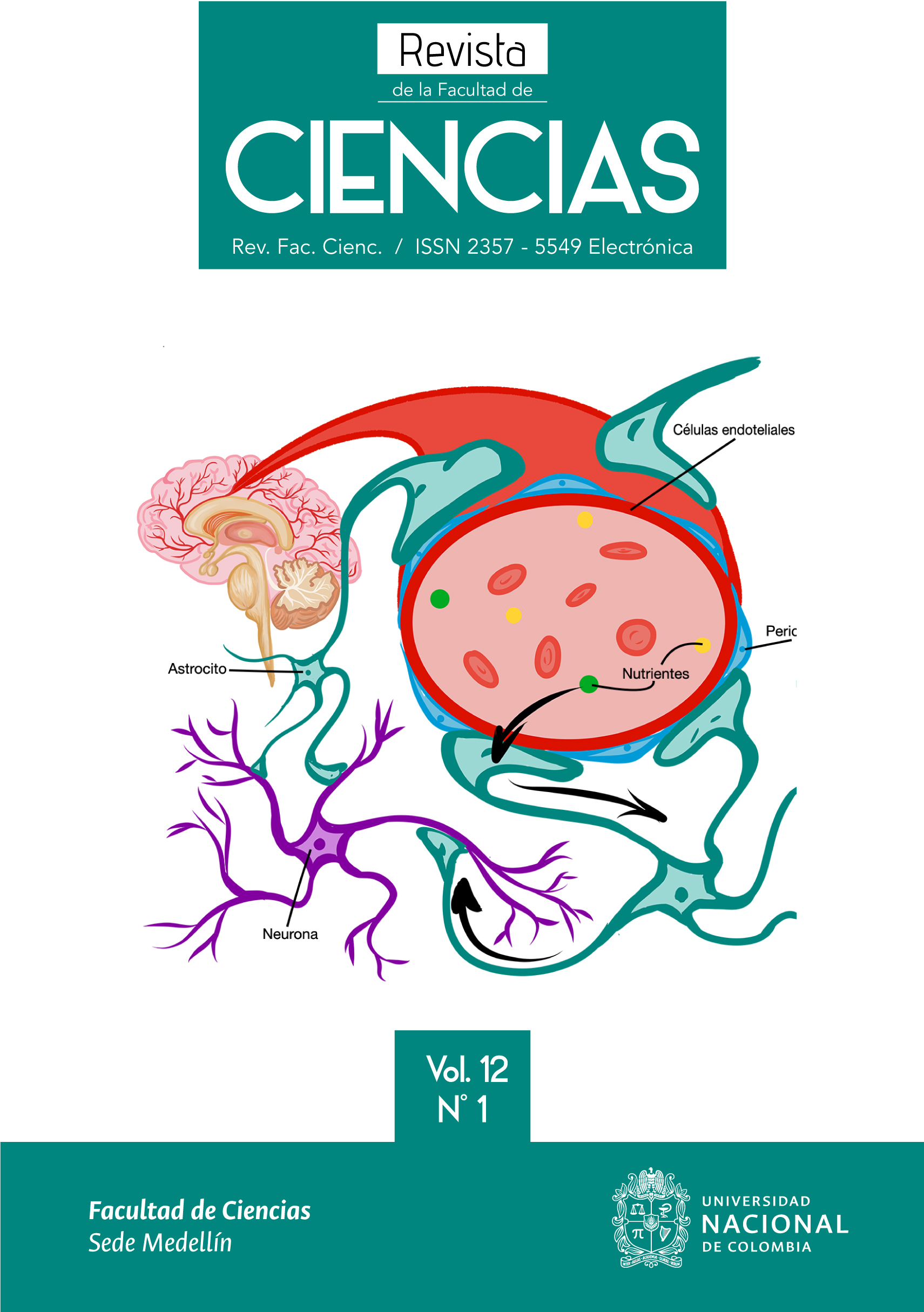EL SISTEMA NERVIOSO, UNA VÍCTIMA MÁS DEL SARS-COV-2
THE NERVOUS SYSTEM, ANOTHER VICTIM OF SARS-COV-2
DOI:
https://doi.org/10.15446/rev.fac.cienc.v12n1.102953Palabras clave:
SARS-Cov-2, ACE2, cerebro, nociceptores, bulbo olfatorio (es)SARS-CoV-2, ACE2, brain, nociceptors, olfactory bulb (en)
Descargas
El COVID-19 es la enfermedad provocada por el SARS-CoV-2, el virus que desencadenó la instauración de medidas preventivas de confinamiento desde principios de 2020. En un inicio, se identificó a la proteína S del virus como la “llave” que, dada su gran afinidad por el receptor ACE2, promueve la entrada al cuerpo humano. ACE2 se encuentra expresado en diferentes tejidos, y por lo tanto, son más propensos a presentar alteraciones al estar expuestos al virus. En el encéfalo encontramos dos regiones con ACE2 altamente expresado: 1) el bulbo olfatorio, razón por la cual se sugiere que esto puede facilitar la entrada del virus hacia el SNC, e incluso se considera que explica la pérdida de olfato y 2) el tallo cerebral, que resulta de especial importancia porque el complejo Pre-Bötzinger se sitúa embebido en dicha estructura y regula el ritmo respiratorio mediante la coordinación de quimiorreceptores que sensan la saturación de O2 y CO2, lo que da paso a un decremento en el suministro de oxígeno. Además, parte de las alteraciones en el SNP se piensa que se generan a partir de la interacción del virus con los nociceptores dando paso a síntomas como dolor muscular y de cabeza.
COVID-19 is the name of sickness headed by SARS-CoV-2, which gated the confinement restrictions since March 2020. At the beginning the S protein was identified as the “key” that enhances entering human body, due to its affinity with ACE2 receptor. ACEOXÍ receptor is known to be expressed in a variety of tissues in a manner in which that location increases their infection-probabilities in exposure to this virus. The brain contains two regions where ACE2 is manly expressed: 1) The olfactory bulb which is thought to be involved in loss of smell and facilitating entering to the Central Nervous System, on the other hand 2) the brainstem keeps imbibed the Pre-Bötzinger complex, a mediator of respiratory rhythm, showed its implications in oxygen depletion because of abnormal working of O2, and CO2 sensing chemoreceptors, on the other hand 2) the brainstem keeps within the Pre-Bötzinger complex, a mediator of respiratory rhythm, showed its implications in oxygen depletion because of abnormal working of O2, and CO2 sensing chemoreceptors. In concern with PNS it is considered virus-nociceptors interaction as the most likely reason to muscular pain and headache.
Referencias
Ali, A.M. & Kunugi, H. (2021). Skeletal Muscle Damage in COVID-19: A Call for Action. Medicina 57(4), 372. https://doi.org/10.3390/medicina57040372
Alomari, S.O.; Abou-Mrad, Z. & Bydon, A. (2020). COVID-19 and the central nervous system. Clinical neurology and neurosurgery, 198, 106116. DOI: https://doi.org/10.1016/j.clineuro.2020.106116
Baig, A.M., Khaleeq, A., Ali, U. & Syeda, H. (2020). Evidence of the COVID-19 Virus Targeting the CNS: Tissue Distribution, Host-Virus Interaction, and Proposed Neurotropic Mechanisms. ACS Chemical Neuroscience 11(7), 995-998. DOI: https://doi.org/10.1021/acschemneuro.0c00122
Barichello, T., Collodel, A., Hasbun, R. & Morales, R. (2019). An Overview of the Blood- Brain Barrier. Eds. Blood-Brain Barrier. Neuromethods, vol 142. Humana Press, New York, NY., 1–8. DOI: https://doi.org/10.1007/978-1-4939-8946-1_1
Bliddal, S., Banasik, K., Pedersen, O.B., Nissen, I., Cantwell, L., Schwinn, M., Tulstrup, M., Westergaard, D., Ullum, H., Brunak, S., Tommerup, N., Feenstra, B., Geller, F., Ostrowski, S. R., Grønbæk, K., Nielsen, C.H., Nielsen, S.D. & Feldt-Rasmussen, U. (2021). Acute and persistent symptoms in non-hospitalized PCR-confirmed COVID- 19 patients. Scientific Reports 11, 13153. DOI: https://doi.org/10.1038/s41598-021-92045-x
Esakandari, H.; Nabi-afjadi, M.; Fakkari-afjadi, J.; Farahmandian, N.; Miresmaeili, S. & Bahreini, E. (2020), A comprehensive review of COVID-19 characteristics. Biological procedures online 22(1), 1-10. DOI: https://doi.org/10.1186/s12575-020-00128-2
Graham, E.L.; Clark, J.R.; Orban, Z.S.; Lim, P.H.; Szymanski, A.L.; Taylor,C.; Dibiase, R.M.; Tong Jia, D.; Balabanov, R.; Ho, S.U.; Batra, A.; Liotta, E.M. & Koralnik, I. J. (2021), Persistent neurologic symptoms and cognitive dysfunction in non- hospitalized Covid-19 “long haulers.” Annals of Clinical and Translational Neurology, 8(5), 1073–1085. DOI: https://doi.org/10.1002/acn3.51350
Hernandez, V.S.; Zetter, M.A.; Guerra, E.C.; Hernandez-Araiza, I.; Karuzin, N.; Hernandez-Perez, O.R.; Eiden, L.E. & Zhang, L. (2021), ACE2 expression in rat brain implications for COVID-19 associated neurological manifestations. Experimental Neurology 345, 113837. DOI: https://doi.org/10.1016/j.expneurol.2021.113837
Hill, R., A; Wyse, G. & Anderson, M. (2012), Aerobic and anaerobic forms of metabolism. In Animal Physiology. Eds. Sinauer associates, 183-206.
Khan, S.; Shafiei, M. S.; Longoria, C.; Schoggins, J.W.; Savani, R.C. & Zaki, H. (2021), SARS-CoV-2 spike protein induces inflammation via TLR2-dependent activation of the NF-κB pathway. ELife, 10, e68563. DOI: https://doi.org/10.7554/eLife.68563
Mcfarland, A.J.; Yousuf, M.S.; Shiers, S. & Price, T.J. (2021), Neurobiology of SARS- CoV-2 interactions with the peripheral nervous system: implications for COVID-19 and pain. Pain reports 6(1), e885. DOI: https://doi.org/10.1097/PR9.0000000000000885
Sawa, T. & Akaike, T. (2022), What triggers inflammation in COVID- 19?. ELife, 11:e76231. DOI: https://doi.org/10.7554/eLife.76231
Spudich S. & Avindra, N. (2022), Nervous system consequences of COVID-19. Science, 375(6578), 267-269. DOI: https://doi.org/10.1126/science.abm2052
Shabani, Z. (2021), Demyelination as a result of an immune response in patients with COVID-19. Acta Neurologica Belgica 121(4), 859-866. DOI: https://doi.org/10.1007/s13760-021-01691-5
Shiers, S.; Ray, P.R.; Wangzhou, A.; Sankaranarayanan, I.; Tatsui, C.E.; Rhines, L.D.; Li, Y.; Uhelski, M.L.; Dougherty, P.M. & Price, T. J. (2020), ACE2 and SCARF expression in human dorsal root ganglion nociceptors: implications for SARS-CoV-2 virus neurological effects. Pain 161(11), 2494–2501. DOI: https://doi.org/10.1097/j.pain.0000000000002051
World Health Organization COVID-19 Explorer (2020). Geneva: World Health Organization. [cited 2022 May 30]. https://worldhealthorg.shinyapps.io/covid/
Cómo citar
APA
ACM
ACS
ABNT
Chicago
Harvard
IEEE
MLA
Turabian
Vancouver
Descargar cita
Licencia
Derechos de autor 2023 Revista de la Facultad de Ciencias

Esta obra está bajo una licencia internacional Creative Commons Atribución-NoComercial-SinDerivadas 4.0.
Los autores o titulares del derecho de autor de cada artículo confieren a la Revista de la Facultad de Ciencias de la Universidad Nacional de Colombia una autorización no exclusiva, limitada y gratuita sobre el artículo que una vez evaluado y aprobado se envía para su posterior publicación ajustándose a las siguientes características:
1. Se remite la versión corregida de acuerdo con las sugerencias de los evaluadores y se aclara que el artículo mencionado se trata de un documento inédito sobre el que se tienen los derechos que se autorizan y se asume total responsabilidad por el contenido de su obra ante la Revista de la Facultad de Ciencias, la Universidad Nacional de Colombia y ante terceros.
2. La autorización conferida a la revista estará vigente a partir de la fecha en que se incluye en el volumen y número respectivo de la Revista de la Facultad de Ciencias en el Sistema Open Journal Systems y en la página principal de la revista (https://revistas.unal.edu.co/index.php/rfc/index), así como en las diferentes bases e índices de datos en que se encuentra indexada la publicación.
3. Los autores autorizan a la Revista de la Facultad de Ciencias de la Universidad Nacional de Colombia para publicar el documento en el formato en que sea requerido (impreso, digital, electrónico o cualquier otro conocido o por conocer) y autorizan a la Revista de la Facultad de Ciencias para incluir la obra en los índices y buscadores que estimen necesarios para promover su difusión.
4. Los autores aceptan que la autorización se hace a título gratuito, por lo tanto renuncian a recibir emolumento alguno por la publicación, distribución, comunicación pública y cualquier otro uso que se haga en los términos de la presente autorización.
5. Todos los contenidos de la Revista de la Facultad de Ciencias, están publicados bajo la Licencia Creative Commons Atribución – No comercial – Sin Derivar 4.0.
MODELO DE CARTA DE PRESENTACIÓN y CESIÓN DE DERECHOS DE AUTOR





















